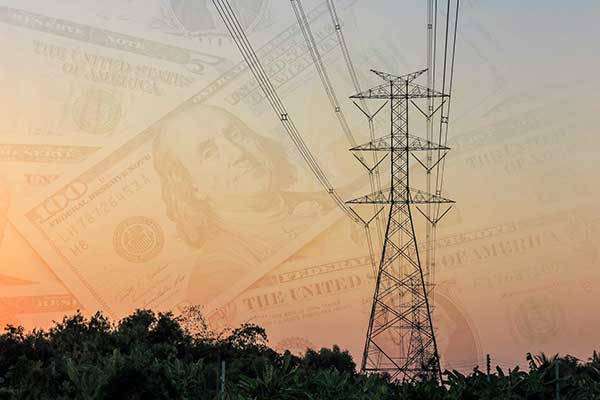Do you ever wonder how energy providers determine the pricing for their electricity plans? Or how your monthly electricity bill can vary so drastically from month to month even if you maintain similar electricity usage? A competitive energy market with deregulation, like the one in Texas, can seem challenging to dissect since many Texas retail electricity providers (REPs) are competing for your business. In this guide, we break down the basics of Texas electricity rates to help you make sense of it all.
What You Never Knew About Texas Electricity Rates
Do you ever wonder how energy providers determine the pricing for their electricity plans? Or how your monthly electricity bill can vary so drastically from month to month even if you maintain similar electricity usage? A competitive energy market with deregulation, like the one in Texas, can seem challenging to dissect since many Texas retail electricity providers (REPs) are competing for your business. In this guide, we break down the basics of Texas electricity rates to help you make sense of it all.
Power to Choose Texas: A Guide for Texas Electricity Rates
How Are Texas Electricity Rates Determined?
There are multiple factors that affect the electricity market. According to the U.S. Energy Information Administration (EIA), the most significant component is the expense of electricity generation.
The costs that electricity companies face when building, operating, maintaining, and financing their power plants is high, so of course, it’s reflected in their pricing. This is a fairly standard practice for any industry. Let’s take a look at the other main factors influencing Texas electricity rates.
Fuel Prices
Pricing for natural gas and petroleum-based fuels tends to rise during periods of high electricity demand. Fuel supply disruptions or constraints from extreme weather events or other issues also cause fuel prices to increase. When fuel prices rise, the cost to generate electricity also goes up.
Power Grid
The power grid, or electricity transmission and distribution systems that connect power plants with consumers, also comes with ongoing expenses. Much like the power plants, there are ongoing costs for operation, regular maintenance, storm, and accident-related repairs, and other necessary improvements.
Weather Conditions
We all know about supply and demand. Electricity rates are no different. When temperatures become extremely hot or cold, the electricity demand for operating in-home cooling and heating systems ramps up.
The drastic increase in demand contributes to rising electricity prices, which are usually highest in the summer due to running air conditioners and other cooling devices. Severe weather can also cause power outages and equipment damage, often leading to additional expenses.
On the contrary, we also use weather to reduce electricity rates. There are a number of low-cost renewable energy options that can save money on electricity generation. With a bit of help from the rain or snow, we can use hydropower; the wind helps us to generate wind energy; and the sun generates solar power. Those are just a few of the renewable energy sources that we currently use for electricity generation.
State Regulations
In some states, utility or public service commissions fully regulate pricing. Other states may have a combination of regulated and unregulated pricing. While the state of Texas has a fully deregulated energy market, the Public Utility Commision (PUC) of Texas has been in charge of regulating electricity rates for Texans since 1975. The goals of the PUC of Texas are to protect consumers, ensure high-quality service, and increase competition in the electricity market where possible.
The Electric Reliability Council of Texas (ERCOT) also plays an essential role in electricity pricing for Texas residents. Their part is to manage the Texas power grid and control the prices that power generators charge the retail electric providers (city utilities and power companies).
In addition, ERCOT can remove electricity providers unable to make their payments from the energy market, which happened with Griddy Energy after the February 2021 winter storm crisis.
Economic Conditions
Growing economies tend to have increased infrastructure demands. This drives up the energy demand and, in turn, energy costs. By contrast, reduced demand and lower costs generally complement economies that are performing poorly.
Availability of Supply
Since most of our energy generation comes from fossil fuels, such as coal and natural gas, we have to start thinking about availability. While it’s currently inexpensive to use fossil fuels to generate energy, as we get closer and closer to depleting the supply, the cost will rise. Fortunately, it’s increasingly more affordable to use renewable energy sources to generate electricity.
Location
Similar to availability of supply (as in how much remains in existence), pricing also varies based on proximity. This refers to how much supply is available in your specific area. If you’re in a community that can generate electricity using local resources, your electricity costs will be lower.
For example, the annual average price of electricity in 2020 ranged from 27.67¢ per kilowatt-hour (kWh) in Hawaii (where fuel has to be imported) to 7.46¢ per kilowatt-hour in Oklahoma.
What Is Price Volatility?
As mentioned, energy prices vary based on changes in supply and demand. When the supply increases, average prices go down. When there’s a shortage, average prices will rise. Price volatility is the description of how widely or quickly prices can change. Before moving on, let’s do a quick recap of what we’ve covered so far.
Texas electricity rates are influenced by:
- Cost for electricity generation and other power plant expenses
- Power grid operation and maintenance costs
- Economic conditions
- Availability of supply
- Weather conditions
- State regulations
- Fuel prices
- Location
Enter your ZIP Code and compare electricity rates
Does My Energy Plan Type Affect My Electricity Bills?
All Texas electricity plans have an electricity facts label (EFL) which outlines the plan’s details. EFLs include the average price per 500 kWh, 1,000 kWh, and 2,000 kWh so that it’s easy to compare offers.
Additional information frequently listed on EFLs includes:
- Base charges
- Delivery charges, or TDSP
- Length of contract
- Early termination fees
- Broken contract fees
- Payment methods accepted
- Other charges, fees, and taxes
- Type of plan
4 Main Types of Energy Plans
The type of energy plan you choose also has a significant impact on your electricity bills. It’s vital to understand how these plans work before selecting which one is best for you since they determine your bill’s structure. Let’s take a look at the four plan types.
1. Fixed-Rate Plans
Fixed-rate plans are contracted for a set period and offer the most stability. If you’re not a fan of surprises and prefer to know what your monthly bill will be before you receive it, consider choosing a fixed-rate plan.
In the event of severe weather or another energy crisis, you can rest easy knowing that your electricity prices will remain steady for the duration of your contract. Fixed-rate plans offer protection from market price volatility. Any changes in commodity prices won’t affect you.
2. Variable-Rate Plans
If contracts and budgeting aren’t your thing and you prefer a bit more freedom, then a variable-rate plan might be what you’re looking for. With these plans, you’re typically allowed to change electricity providers penalty-free whenever you’d like. So, if you enjoy continually surfing for lower rates, this type of energy plan may be for you. Just keep in mind that with this flexibility comes the risk of a (sometimes drastic) fluctuating electric rate that you can’t always avoid.
Since variable rate plans mirror the market rates, this plan exposes consumers to market price volatility. That means choosing a variable-rate plan is ideal when electricity rates are stable or expected to decrease.
3. Indexed-Rate Plans
Indexed-rate energy plans are more or less the sweet spot between fixed-rate and variable-rate plans. Some indexed-rate plans come with a contract, while others are month-to-month.
Either way, your energy rates can fluctuate monthly. Your monthly energy rate is determined based on a formula that uses a public index. While there’s still the risk of a higher than usual electric bill, it can be comforting to see exactly how your monthly bill’s pricing is determined.
4. Prepaid Plans
Prepaid energy plans allow you to make payments for your electric bill upfront. There are no deposits or contracts with prepaid plans. Still, you’ll want to make sure you have a good understanding of your monthly electricity usage since you get what you pay for. Consumers who have little or no credit and those looking for short-term electricity plans often choose to use a prepaid energy plan.
How Frequently Do Electricity Rates Change?
Here’s a crazy fact: electricity rates vary minute by minute.
Electricity is in demand every second of the day, every day of the year. However, the electricity usage amount is ever-changing. The real-time cost of supplying electricity reflects on the electric power grid as the wholesale price.
When electricity is in the highest demand, it’s called peak hours. This typically occurs during the afternoon and early evening hours. Real-time electricity costs are highest during those peak hours, while the best electricity rates occur during non-peak hours.
Although most consumer energy bills reflect average prices rather than time-of-day pricing, there are other options. Some Texas electricity providers offer free nights and weekend plans or give bill credits for using electricity during non-peak hours to encourage energy conservation.
What Are the 4 Types of Electrical Customers?
The final factor that determines your Texas electricity rate is the type of customer you are. We classify utility customers into four different categories:
- Residential
- Commercial
- Transportation
- Industrial
Supplying electricity to industrial customers is more efficient and affordable for energy companies than providing electricity to other consumers. This is because industrial customer energy usage is significantly greater than others, and they can receive the electricity at higher voltages.
Homeowners wind up paying the highest electricity prices since their distribution costs are higher than other customer types. In 2020, the annual average prices for electricity were 13.20¢ per kWh for residential customers, 10.65¢ per kWh for commercial customers, 9.20¢ per kWh for transportation customers, and 6.66¢ per kWh for industrial customers.
Use Power to Choose for Comparing Competitors and Rates in Your Area
As you can see, there’s quite a bit that goes into determining Texas electricity rates. Fortunately, shopping websites like Power to Choose (PTC), which the Public Utility Commission of Texas (PUC of Texas) created to provide customers like you with clarity, make it possible to find your best electricity plan easily.
Combine the knowledge you now have about electricity plans and rates with this guide to using Power to Choose. Once you’ve finished exploring, it will be simple to select the best energy plan for you.
The Power to Choose | FAQ’s – Your Questions Answered
How Will You Use Your Power to Choose?
Power to Choose is the best tool for comparing and understanding Texas electricity rates. Is there another energy plan out there that will help you save money? When you’re ready, enter your zip code on the Power to Choose or Energy Savings website to see which electric companies provide service to your area and start shopping.
Brought to you by energysavings.com
All images licensed from Adobe Stock.
Featured image:





